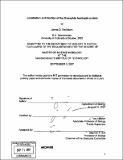| dc.contributor.advisor | J. Troy Littleton. | en_US |
| dc.contributor.author | Mediatore, James D | en_US |
| dc.contributor.other | Massachusetts Institute of Technology. Dept. of Biology. | en_US |
| dc.date.accessioned | 2008-03-27T18:39:26Z | |
| dc.date.available | 2008-03-27T18:39:26Z | |
| dc.date.issued | 2007 | en_US |
| dc.identifier.uri | http://hdl.handle.net/1721.1/40981 | |
| dc.description | Thesis (S.M.)--Massachusetts Institute of Technology, Dept. of Biology, 2007. | en_US |
| dc.description | "September 3, 2007." | en_US |
| dc.description | Includes bibliographical references (p. 34-40). | en_US |
| dc.description.abstract | Huntington's Disease (HD) is an autosomal dominant neurodegenerative disorder caused by an expansion of a polyglutamine tract in the huntingtin protein. This mutation leads to conformational instability, resulting in huntingtin aggregation and degeneration of neurons in the striatum and cortex. HD is characterized by motor dysfunction, personality changes, dementia, and early death. Although a number of abnormal cellular phenomena have been described in systems modeling HD, the specific events initiating pathology remain unclear. It is widely viewed that inclusions may have a toxic gain-of-function which is central to HD pathogenesis. However, evidence is accumulating that supports the loss of huntingtin function as a likely contributor to the unraveling of cellular processes early in the course of the disease. The fruit fly Drosophila melanogaster has an orthologous huntingtin gene with several regions showing 40-50% similarity to mammalian huntingtin at the amino acid level. Like the mammalian huntingtin gene, the fly huntingtin lacks sequence motifs that would suggest functional correlates to other known proteins. I have pursued a cell biological and physiological analysis of Drosophila melanogaster mutants with reduced huntingtin gene expression. Normal levels of huntingtin were not required for normal localization of mitochondria in neurons, synaptic transmission in the visual system, or formation of synapses. | en_US |
| dc.description.statementofresponsibility | by James D. Mediatore. | en_US |
| dc.format.extent | 40 leaves | en_US |
| dc.language.iso | eng | en_US |
| dc.publisher | Massachusetts Institute of Technology | en_US |
| dc.rights | M.I.T. theses are protected by
copyright. They may be viewed from this source for any purpose, but
reproduction or distribution in any format is prohibited without written
permission. See provided URL for inquiries about permission. | en_US |
| dc.rights.uri | http://dspace.mit.edu/handle/1721.1/7582 | en_US |
| dc.subject | Biology. | en_US |
| dc.title | Localization and function of the Drosophila huntingtin protein | en_US |
| dc.type | Thesis | en_US |
| dc.description.degree | S.M. | en_US |
| dc.contributor.department | Massachusetts Institute of Technology. Department of Biology | |
| dc.identifier.oclc | 213299014 | en_US |
